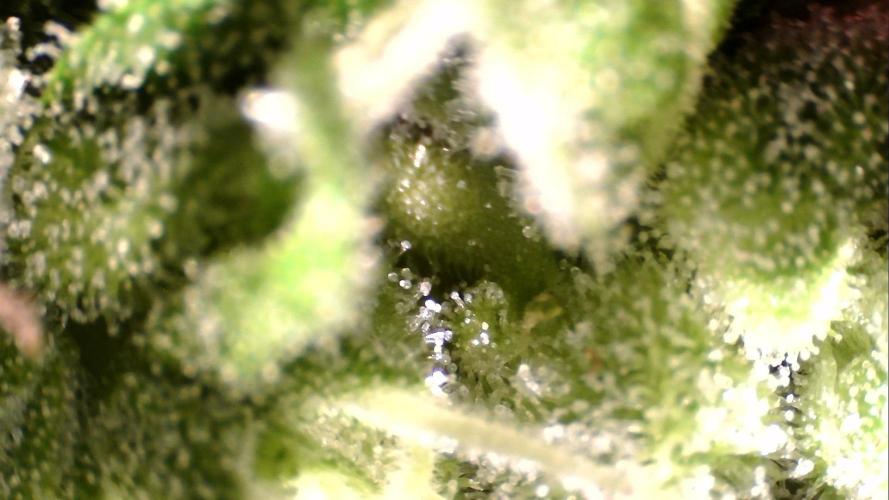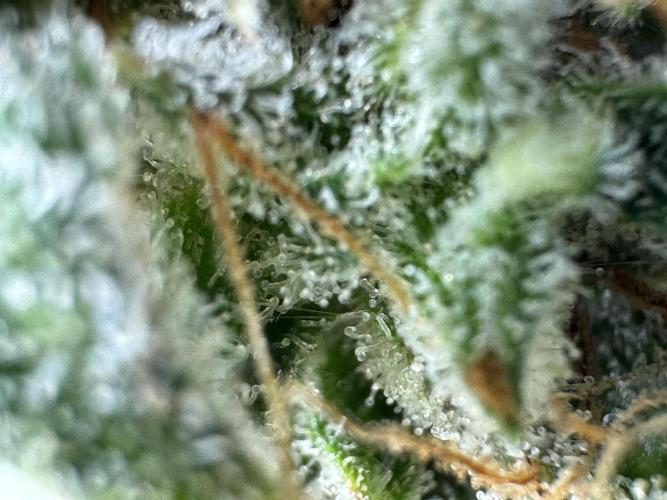The Grow Awards 2026 🏆 

























Looking for mentors
SirSalamistarted grow question 3y ago
First-timer here with a new diary. If you have the time, please follow or just check out what I have so far. I'm excited to learn more about my plant, how to record/report progress, and growing in general. Any advice/comments/concerns will be very much appreciated. Thank you!
Solved
Other. General questions
likes
Sciolistic_Steveanswered grow question 3y ago
"I would've liked to have added perlite to the soil mix. Hoping to learn more about the possibility to add more to the existing mix before doing anything."
Defintely.. perlite or similar should be 50% of volume. With coco, you can drop to 30% because coco holds less water per volume. A little less is no big deal, too. Best for roots and growth but will increase rate of irrigation.
2gallon pot may need more frequent irrigation at end, possibly daily, but doable. Better in a soilless context though.. toward end you may have to treat your soil like a soilless substrate and provide everything each irrigation for best results.
pH in soil is usually easier to handle. it's good to pH balance anything you add, but many don't bother. They are probably lucky with some good tap water or RO system. 6.5-6.8 .. just keep it under 7, but even 7-7.5 won't be the end of the world in most cases. Still, keep it under 7 to be safe.
Watering - change your perspective. this requires a little hindsight but after 1 cycle you can calculate it and mix up what you need with limited waste. Don't give a specific volume you choose. you give what it needs when it needs it, and you use the weight of the pot to determine when to irrigate. Allow top 1" to dry, feel weight of pot and irrigate until you get mnimal runoff to ensure the entire thing is wet. Dry pockets are no good over time. Repeat that process and be familiar with low-weight level... you'll find the volume on next irrigation that you can plan for per pot... then mix appropriate volumes based on that when fertilizing.
You can irrigate more frequently (ie before "1" deep" dries), but always make sure some dryback occurs. if perpetually too wet it invites all sorts of problems. This is where the 50% perlite would pay off. With potentially big plants in small-ish pots, you'll know when you can get away with an early irrigation rather than let it sit overnight or something.
As of day 6 that cfl seems to be doing well-enough. You can tell be internode distance -- length between growth nodes. If it stretches too much, you need more light. If it remains too compact, you need less light. Early on, you'll start low and ramp up as you observe the plant... While it won't be exactly the same for every plant, it'll be in the same ballpark. Take notes until it's memorized or comfortable observing/reacting.
if far enough away and dimmed properly, can use the 100w sf light anytime you want. no matter what, you adjust to whet the plant dictates. This way you can really gas it when they ask for it and avoid damaging any that may take a bit more time to handle it.
Similar Grow Questions
Solved

Dingle_Dangle
STRAIN for AUTUMN GREENHOUSE GROW EXPERIMENTI would like to experiment a greenhouse grow, so basically an outdoor grow but under a "transparent tent", with sun as only source of heat and light.
I've never done this before. I was thinking to germinate in early/mid september. Suggestion for the strain? Auto ofc. Experiences?
Other. General questions
4y ago
3
5
Solved

Heisenbud
Lets talk about the white widow for a bit. (middle plant in the picture)
I want to know why it isn't growing as fast (if fast is even the right term) as the others.
The stock is by far the thickest of the three, but the growth up top is scarce. What gives!?!?!?!
Week 8
Other. General questions
5y ago
2
1
Solved

Phaleg
Tricomes evaluation please!Hi!
I'd like to kindly ask experts for tricomes evaluation of 2 plants of "Night Queen Automatic" from Dutch Passion. (4photos + 4 photos)
Please forgive photo quality, I tried many times and this is the best I got.
(for more details, I have a diary about them).
Thanks
Buds. Other
Other. General questions
Plant. Other
5mo ago
3
4
Solved

BullWeedDog
he comprado este insecticida que su composición es Lambda cihalotrin y Benzisotiazol puedo utilizarlo en mis plantas??ha mi planta le esta empezando a caer mosca del mantillo y trips he comprado este insecticida pero luego de llegar a casa me he dado cuenta que no tiene piretrina, y como no es de ninguna marca especializada en cannabis quería saber si lo puedo utilizar que me dicen??
Other. Bugs
Other. General questions
Setup. Substrates
4y ago
1
1
Solved

PeterGrowfin
Slowing down/canceling stretch?Are there any ways to do this in a Low-Stress type? Would a late ScrOG net help to keep the stretch small? LED -> Plant distance is currently (week 5) ~34cm (~20cm left befor she might suffer from lightburn). LED is not moveable. Plant itself is healthy.Week 4
Other. General questions
6y ago
3
2
Solved

SakuraAsa
Male-Female decisionsHello, growers!
Is this individual a male or a female?
Regular seeds.
The height is about 90 inches.
Other. General questions
Setup. Outdoor
5y ago
2
4
Solved

absdasdbadb
Am I within the chop window?Currently on day 75 of this meph sour stomper. I feel like today is chop day, am I right ?
I see mostly cloudy/amber on the calyxes and the leaves are discoloring - despite me not stopping the feed - which seems to indicate she's grabbing all the food she can and near done.
Other. Harvest - Drying
Other. Harvest - Curing
Other. General questions
4mo ago
3
5
Solved

Skylife
FeedbackJust want some feedback on my most current harvest, sherbet from seedstockers. First grow, tbh quite chuffed with this as weather has been way too hot where I am and had a slight affect got 28 grams off herOther. Harvest - Curing
Other. General questions
5y ago
1
Solved

RJW1989
Will October/November harvest time (in a UK Greenhouse) hurt my plant or decrease yield etc?If my greenhouse-girl will flip to flowering in late August, will temperatures during the estimated harvest time of late October (or even early November) (in uk conditions...) damage or hinder my plant at all?
Thanks guysOther. General questions
3y ago
2
2
Solved

Thatsmyfirsttime
Hey :) just a check up, how is she doing? She should be ready in w week, but I'm planning to let her flower a bit more. What do you think?
Other. General questions
5y ago
1
1
Solved

Joyfull420
Help me understand my soilHi guys I found the soil I'm using on a website, if somebody who knows what there talking about could take a look, that would be great,
https://www.bonprix.co.uk/products/growmoor-40-litre-multi-purpose-compost/_/A-26E933_?utm_source=GoogleProductList&utm_medium=GoogleProductLisOther. General questions
5y ago
1
1
Solved

VicMallorca
Limpieza de raíces como hacerlo?Como se limpian bien las raices ?cuantos días son necesarios?Week 9
Other. General questions
3y ago
4
4
Solved

Darth_Vaper
Lights on power stripMy power strip is inside the tent. It has four constant power sockets and four time programable sockets. My question is, should I be worried about the light coming from the orange lit up power switch and LED screen during the flowering stage?Week 1
Other. General questions
5y ago
2
2
Solved

snowmanbl90d
PH TestingI have a vivosum ph meter, a ph tester for the up/down ph liquids and ph test strips. All of them don't seem to agree with each other with in a range of 1 ph across the ph scale. My question is what is the most reliable or is there a different method I should use?
5y ago
3
4
Solved

Dreamaster
High temps for sprouting seedlings on day oneMy seedlings sprouted into a dark space with 29°C temps and a humidity of 25%. They were covered, and it was only for a few hours on day one. Has the exposure to excess temps killed them, or is there a chance they will fully recover?
Week 1
Other. General questions
6y ago
5
5
Solved

Feanor
ASAP SOS Help Seedling health problem new grower.ASAP SOS Help for my baby girl 1 of my girls going weak last 2 days and stopped growing. I can see the body under the medium is goin thinner and weaker. what can be the cause ? What can I provide for her healing ? (I marked the thinning part in red circle)
Hear my voice growe
Other. General questions
3y ago
4
4






